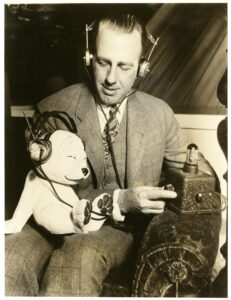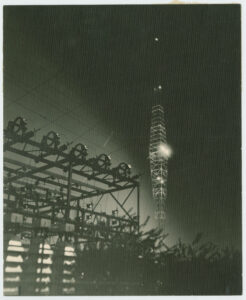Voice of America

The 1930s were considered the golden age of radio. During that time, commercial radio broadcasts became a main source of news and entertainment for most Americans; U.S. president (and Ohio native) Warren G. Harding even had one installed in the White House. After the 1941 attack on Pearl Harbor, however, radio took on a new role of promoting U.S. interests abroad. A major part of this effort was Voice of America (VOA).

In the years before World War II, all U.S. shortwave radio stations were held by private companies. Even before Pearl Harbor, however, the federal government had started to provide news to private stations for voluntary international broadcast. Direct government radio broadcasts to Asia began the week after Pearl Harbor through the Foreign Information Service’s San Francisco office. Robert E. Sherwood, a speechwriter for Franklin D. Roosevelt, coined the term “The Voice of America” to describe the new radio network that began transmitting on February 1, 1942, from New York City. On February 24, 1942, VOA made its first broadcast to Germany; you can listen to the beginning of that broadcast on VOA’s website here. VOA continued to promote U.S. interests and combat propaganda throughout the war.
In 1943 the federal government purchased land in Butler County to build the Bethany Relay Station, which would act as a failsafe if East Coast transmitters were damaged by enemy forces. The station’s 200,000 watt transmitters were built by Crosley Broadcasting Corporation, which was owned and operated by Cincinnati native Powel Crosley Jr., an entrepreneur who became interested in radio in the early 1920s. After developing a more affordable radio, he quickly became the world’s leading radio manufacturer. Realizing that radios need programming, Crosley then expanded into broadcasting. The Bethany station began transmitting Voice of America programs in 1944, with Crosley Broadcasting Corporation operating the site for the federal government. The programming was successful enough that Adolf Hitler tried to mitigate the damage by referring to Voice of America as the “Cincinnati liars.”

Although Voice of America discontinued many programs after World War II, it ramped up operations at the beginning of the Cold War as one way to combat communism abroad. Although VOA programming was not available to U.S. listeners from 1948-2013, broadcasts were transmitted worldwide. They included a wide range of material, including the Voice of America Jazz Hour (1955-2003) and a weekly program by a New York high school senior named Billy Brown, who talked about everyday events in his hometown (1953). Brown’s program was a victim of its own success; it was cancelled after nine months because Brown received so much fan mail that VOA couldn’t afford to respond to listeners’ letters.
Despite management changes and budget cuts, Voice of America continued to broadcast news to the world. When Neil Armstrong stepped onto the moon in 1969, nearly 800 million people tuned in to VOA’s live coverage. Today, VOA broadcasts in 48 languages across multiple media and platforms; in 2022 it reached approximately 326 million weekly listeners and viewers worldwide.
Voice of America took over operational control of the Bethany Relay Station in 1963, but the site ceased operations in 1994 as transmission shifted from broadcasting towers to satellites. The Bethany Station building is now the National Voice of America Museum of Broadcasting; exhibits cover the history of Voice of America, Powel Crosley Jr., and radio and television broadcasting.
Thank you to Stephanie Michaels, Research and Catalog Services Librarian at the State Library of Ohio, for this week’s post!



Leave a Reply
You must be logged in to post a comment.